» Plasma For Materials
Plasma treatments induce chemical and physical surface changes in materials through activation, etching, grafting, film deposition, implantation, polymerisation and cross-linking processes. Surface properties of materials can be modified in order to impart or to improve hydrophilic properties, water repellence, dye-ability, wet-ability, adhesion, gas-moisture-barrier properties, UV barrier properties, oleo-repellence properties, antistatic properties, flame retarding properties, biocompatibility [1,2,3]. In the centre PLASMAPROMETEO several plasma processes have been studied and applied to different materials such as textiles, lignocellulosic fibres, polymers, leathers, wood, ceramic materials, plastics [4,5,6,7]. The relevant sectors of applications are packaging, biomedicine, food, textile, health, optics, sensors, environment, energy.
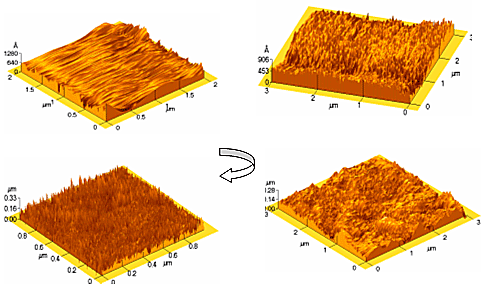
PET fibres at AFM: increase of roughness by plasma treatment (exposure time: 0, 30 ,60, 90 seconds)
 COTTON FABRICS: Water repellence
COTTON FABRICS: Water repellence
SILK: chemical and plasma degumming Untreated Chemically degummed Plasma etching
Untreated Chemically degummed Plasma etching
 PET: wet-ability
PET: wet-ability
 LEATHER: Water repellence
LEATHER: Water repellence
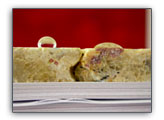
CERAMIC MATERIALS: UV resistance
» Plasma treatment for biomedical application
PLASMAPROMETEO works in the biomedical [8] and micro-filtration sector for improving properties of materials such as membranes, medical devices, prothesis, etc. The innovation of the technology resides on surface functionalization at a nanometric scale, in order to make such materials biocompatible with human tissues avoiding for instance bacterial adhesion to the surface.
Plasma Processes for biomedical materials have a large impact in the sector of health, safety, environment, and they can be used in the field of device construction for medical use.
 PP MEMBRANES: anti-fouling
PP MEMBRANES: anti-fouling
» Plasma Deposition of nanostructured thin films
Nanostructured materials represent a wide and important field for research and technological applications. Nano-materials exhibit many advantages and properties which make them very different from conventional materials and useful for energetic, electronic and structural applications. Plasma Prometeo patented an innovative plasma deposition technique for nanostructured thin films deposition (Plasma Assisted Supersonic Jet Deposition) which splits the deposition process in two steps. First a dense oxidizing plasma dissociates the metallic precursor, then the nucleation and deposition of molecular clusters takes place in another vacuum chamber with a supersonic jet’s expansion. In this way we can easily control and modify both the chemistry and the morphology of the film [11,12]. The depositions of nanostructured thin films are realized with the plasma source PIUMA.
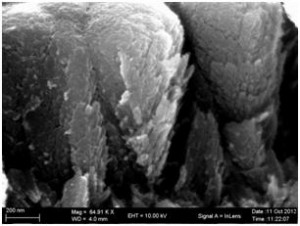 Nanostructured TiO2 thin film obtained with the plasma source PIUMA using PASJD for dye-sensitized solar cells.
Nanostructured TiO2 thin film obtained with the plasma source PIUMA using PASJD for dye-sensitized solar cells.
» Plasma treatment for cultural heritage
Plasma technology is innovative in the field of conservation of degradable materials of particular interest such as lignocellulosic artefacts [9,10]. Plasma surface treatments improve permanent properties such as water repellence, anti-bacteria barriers decreasing the degradation produced by chemical agents (such as acids and pollution) and by biological ones (like bacteria, moulds).
Plasma treatments do not cause bulk modifications and the use of chemical agents is much lower than with conventional treatments, leading to conspicuous economical and environmental advantages.
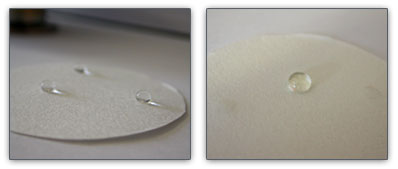 PAPER: water repellence PAPER: oil repellence
PAPER: water repellence PAPER: oil repellence
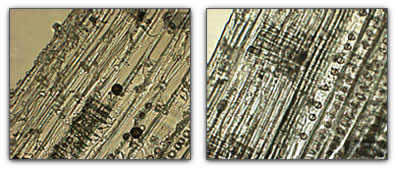 PEARCH: film deposition
PEARCH: film deposition
» Further information is available in papers published in scientific reviews:
[1] “Wettability and dyebility modulation of poly(ethylene terephthalate) fibres through cold SF6 plasma treatment”
R. Barni, C. Riccardi, E. Selli, M.R. Massafra, B. Marcandalli, F. Orsini, G. Poletti, L. Meda
Plasma Processes and Polymers 2, 64-72 (2005)
[2] “Modifications of lignocellulosic fibers by Ar plasma treatments in comparison with biological treatments”
S. Zanini, C. Riccardi, C. Canevali, M. Orlandi, L. Zoia, E.L. Tolppa
Surface & Coatings Technology 200 (1-4), 556-560 (2005)
[3] “Surface modification of PET film by a DBD device at atmospheric pressure”,
P. Esena, C. Riccardi, S. Zanini, M. Tontini, G. Poletti, F. Orsini
Surface and Coatings Technology 200 (1-4), 664-667 (2005)
[4] “Surface properties of HMDSO plasma treated polyethylene terephthalate”
S. Zanini, C. Riccardi, M. Orlandi, P. Esena, M. Tontini, M. Milani, V. Cassio
Surface and Coatings Technology 200 (1-4), 953-957 (2005)
[5] “Plasma Treatment of Silk”
C. Riccardi, R. Barni, P. Esena
Solid State Phenomena 107, 125-128 (2005)
[6] “Cold plasma treatment of PET fabrics:surface morphology characterisation”
G. Poletti, E. Orsini, C. Riccardi, A. Raffaele-Addamo, E. Selli
Pramana Journal of Physics 62, 911-921 (2004)
[7] “Characterization of Plasma Processing for Polymers”
A. Raffaele-Addamo, C.Riccardi, E. Selli, R. Barni, M. Piselli, G. Poletti, F. Orsini, B. Marcandalli, M.R. Massafra, L. Meda
Surface and Coatings Technology 174-5, 886-890 (2003)
[8]”A new synthesis of flumazenil suitable for fluorine-18 labeling”
G. Broggini, M. Orlandi, A. Turioni, C. Zoni
Organic Preparation and Procedures Int 35(6), 609-613(2003)
[9] “Oxidation of milled wood lignin with laccase, tyrosinase and horseradish peroxidase”
S. Grönqvist, L. Viikari, M.-L. Niku-Paavola, M. Orlandi, C. Canevali, J. Buchert
Applied Microbiology and Biotechnology67 (4), 489-494 (2005)
[10] “Laccase mediator system: oxidation of recalcitrant lignin model structures present in residual kraft lignin”
G. Elegir, S. Daina, L. Zoia, G. Sestetti, M. Orlandi
Enzyme and Microbial Technology 37, 340-346 (2005)
[11] “A supersonic plasma jet source for controlled and efficient thin film deposition.”
Biganzoli, I., Fumagalli, F., Di Fonzo, F., Barni, R., & Riccardi, C. (2012).
JOURNAL OF MODERN PHYSICS, 3, 1626-1638.
[12] “Metodo e apparato per la deposizione di strati sottili nanostrutturati con morfologia e nanostruttura controllata ( Nanostrutture). Method and apparatus for depositing nanostructured thin layers with controlled morphology and nanostructure.”
Riccardi, C., Fumagalli, F., Bottani, C., & Di Fonzo, F. (2009).
Brevetto No. MI2009A002107, PCT/EP2010/068539.

